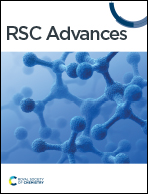Ganoderma lucidum bran-derived blue-emissive and green-emissive carbon dots for detection of copper ions†
Abstract
Ganoderma lucidum bran (GB) has a broad application prospect in the preparation of activated carbon, livestock feed, and biogas, but the preparation of carbon dots (CDs) from GB has never been reported. In this work, GB was applied as a carbon source and nitrogen source to prepare both blue fluorescent CDs (BCDs) and green fluorescent CDs (GCDs). The former were prepared at 160 °C for 4 h by a hydrothermal approach, while the latter were acquired at 25 °C for 24 h by chemical oxidation. Two kinds of as-synthesized CDs exhibited unique excitation-dependent fluorescence behavior and high fluorescent chemical stability. Based on the fantastic optical behavior of the CDs, they were utilized as probes for fluorescent determination of copper ions (Cu2+). In the range of 1–10 μmol L−1, the fluorescent intensity of BCDs and GCDs decreased linearly with the increase of Cu2+ concentration; the linear correlation coefficient reached 0.9951 and 0.9982, and the limit of detection (LOD) was 0.74 and 1.08 μmol L−1, respectively. In addition, these CDs remained stable in 0.001–0.1 mmol L−1 salt solutions; BCDs were more stable in the neutral pH range, but GCDs were more stable in neutral to alkaline conditions. The CDs prepared from GB are not only simple and low-cost, but also can realize the comprehensive utilization of biomass.



 Please wait while we load your content...
Please wait while we load your content...